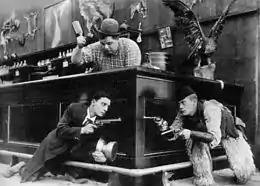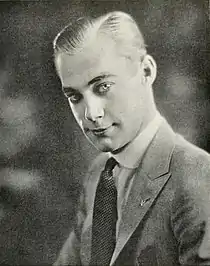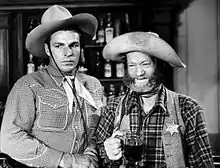Al St. John
Al St. John (September 10, 1892 – January 21, 1963) was an early American film comedian, and nephew of Roscoe “Fatty” Arbuckle, with whom he often appeared on screen. He was employed by Mack Sennett and worked with many leading players such as Charlie Chaplin, Buster Keaton and Mabel Normand. In the talkies, he played the scruffy comedy relief character "Fuzzy Q. Jones" who appeared in dozens of films, including the Producers Releasing Corporation's "Billy the Kid" series from 1940 to 1946 and in that company's "Lone Rider" series from 1941 to 1943.

Al St. John | |
|---|---|
 Who's Who on the Screen, 1920 | |
| Born | Alfred St. John September 10, 1892 Santa Ana, California, U.S. |
| Died | January 21, 1963 (aged 70) Lyons, Georgia, U.S. |
| Occupation | Actor, stunt performer, director, writer |
| Years active | 1912-1962 |
| Spouse(s) | Lillian Marion Ball (1914–1923; divorced); 1 child June Price Pearce (1926–1957) Yvonne St. John (m.19??–19??) Flo-Bell Moore (19??–1963; his death)[1] |
Early life and film career
Born in Santa Ana, California, Alfred was the only child of Nora N. (née Arbuckle) and Walter St. John, who supported the family initially as a farm laborer and later as a house builder. Young "Al“ entered silent films in 1911 working as an extra and in minor character roles. Soon, however, he graduated to co-starring and then to starring roles in comedy shorts for a variety of studios. His uncle on his mother's side, Roscoe "Fatty" Arbuckle, may have helped him in his early days at Mack Sennett Studios, but talent kept Al working. He was also an acrobat.
St. John frequently appeared as Arbuckle's mischievously villainous rival for the attentions of leading ladies such as Mabel Normand and Minta Durfee. He worked with Arbuckle and Charles Chaplin in The Rounders (1914), although his most critically praised film during this period with Arbuckle remains Fatty and Mabel Adrift (1916). In France, he was billed as "Picratt."[2]

When Arbuckle formed his own production company, he brought St. John with him and recruited stage star Buster Keaton into his films, creating a formidable roughhouse trio. After Arbuckle was involved in a widely publicized scandal that prevented him from appearing in movies, he pseudonymously directed his nephew Al as a comic leading man in silent and sound films such as The Iron Mule (1925) and Bridge Wives (1932). Dozens of St. John's early films were screened during the 56-film Arbuckle retrospective at the Museum of Modern Art in New York City in 2006.
As St. John's screen career continued through the 1930s, he was increasingly cast as scruffy, bearded comic characters. He appears, for example, in this type of role in Buster Keaton's 1937 comedy short Love Nest on Wheels, portraying the hillbilly character Uncle Jed.[3] That same year he began supporting cowboy stars Fred Scott and later Jack Randall, but most of his films were made for Poverty Row studio Producers Releasing Corporation (PRC). For that studio, he played "Fuzzy Q. Jones" in the Billy the Kid series starring Bob Steele, the Lone Rider series (starring George Houston and later Bob Livingston), and the Billy the Kid/Billy Carson series starring Buster Crabbe.
The name "Fuzzy" originally belonged to a different actor, John Forrest “Fuzzy“ Knight, who took on the role of "cowboy sidekick" before St. John. The studio first intended to hire Knight for the western series, but then gave the role to St. John instead, who took on the nickname of his rival for his screen character.

Exhibitors loved Fuzzy, who could be counted on to attract moviegoers. Fuzzy's character was the main box-office draw in these films when shown in England and Europe. These ultra-low-budget Westerns took only a bit more than a week to film, so that Crabbe and St. John made 36 films together in a surprisingly short time. When Crabbe left PRC (according to interviews, in disgust at the productions' increasingly low budgets), St. John was paired with new star Lash LaRue. Ultimately, St. John performed in more than 80 Westerns as Fuzzy.
St. John also created a character, "Stoney," in the film The Law of 45's that later appeared, but played by different actors (including John Wayne), in the continuing Western film series The Three Mesquiteers.
Later life and death
St. John acted in more than 350 films during his screen career, which spanned the years from 1911 through 1952. Following the end motion-picture career ended, he made personal appearances at fairs, rodeos, on television programs, at overseas United States military bases, and with traveling companies such as the Tommy Scott Wild West Show.[4] In fact, St. John's death on January 21, 1963 occurred while he was touring with Scott. According to his obituaries, he suffered a massive heart attack at a motel in Lyons, Georgia as he prepared for an appearance at a nearby club of the American Legion. It was also widely reported that the 70-year-old veteran entertainer died at the motel "in the arms of his wife, Flo-Bell Moore".[4][5]
Filmography
References
- Al St. John marital history; accessed March 11, 2014
- Sweeney, Kevin W. (2007). Buster Keaton Interviews. Jackson: University Press of Mississippi. p. 152. ISBN 978-1-57806-963-7.
- "Love Nest on Wheels (1937)", cast credits, catalogue, British Film Institute (BFI), London, United Kingdom. Retrieved February 7, 2021.
- "Al St. John, Western Star, Dies in Lyons", The Atlanta Constitution, 22 January 1963, p. 32. ProQuest Historical Newspapers, Ann Arbor, Michigan; subscription access through The University of North Carolina at Chapel Hill Library.
- "Al St. John, Western Film Comic, Dies", Los Angeles Times, 22 January 1963, p. 4. ProQuest.
Further reading
External links
| Wikimedia Commons has media related to Al St. John. |
- Official website Run by the Estate of Al St. John
- "Saddle Pals & Sidekicks: Al 'Fuzzy' St. John", Old Corral Website
- Al St. John at IMDb
- Al St. John at Virtual History
- Al St. John in Bridge Wives on YouTube